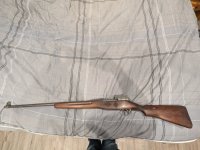Eddystone was the least desirable of the three makers. If the barrel is excellent then someone might want to restore it to military specs. Otherwise as mentioned it's a good, strong, reliable, and usually very accurate truck gun.
I picked up a pretty nice ERA P14 way back in magazine ad days, no pics, limited description, had to deal by phone, guy barely knew what he was describing, lowish 4 digit S/N, made in first month or 2 of production.
Shows up, all matching (barrel/bolt/receiver anyway), but someone turned it into a target rig, PH5B or whatever rear sight, front was milled down to a dovetail for a clamp on PH front globe. It was fully glass bedded in a near new looking M1917 stock, all the steel was still fully blued in great shape, bore clean and sharp but seen low speed lead loads that took a while to scrub out.
Would have been a safe queen if it was all original, condition was amazing.
But it wasn't, I did get an original ERA rear and front sight eventually, rear sights are S/N so it will never match, 1917 bedded stock still on it, it shoots like a house on fire and was under $200, and I got a PH5B that i can throw around on my other P14/M1917's for fun.
Another neat coincidence is the clamp on K31 front globes fit these barrels perfect. Just slide out the front post so it's not in the way, no other mods required for full target sights front and back.










































































